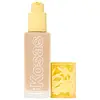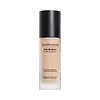Kosas Revealer Skin-Improving Foundation SPF 25 Versus bareMinerals Original Pure Serum Radiant Natural Liquid Foundation Mineral SPF 20
What's inside
What's inside
 Key Ingredients
Key Ingredients

 Benefits
Benefits

 Concerns
Concerns

 Ingredients Side-by-side
Ingredients Side-by-side

Zinc Oxide 7.5%
Cosmetic ColorantWater
Skin ConditioningEthylhexyl Olivate
Skin ConditioningOctyldodecanol
EmollientUndecane
EmollientPolyglyceryl-2 Dipolyhydroxystearate
Skin ConditioningGlycerin
HumectantMica
Cosmetic ColorantCalcium Sodium Borosilicate
Caprylic/Capric Triglyceride
MaskingNiacinamide
SmoothingPolyglyceryl-3 Diisostearate
EmulsifyingGalactoarabinan
Tridecane
PerfumingPropanediol
SolventCetyl Alcohol
EmollientGlyceryl Oleate
EmollientSodium Hyaluronate
HumectantPalmitoyl Tripeptide-5
Skin ConditioningPanthenol
Skin ConditioningSqualane
EmollientCaffeine
Skin ConditioningArnica Montana Flower Extract
MaskingArtemisia Capillaris Flower Extract
Skin ConditioningEthyl Ferulate
AntioxidantSodium Gluconate
Skin ConditioningPolyhydroxystearic Acid
EmulsifyingMaltodextrin
AbsorbentPentylene Glycol
Skin ConditioningLecithin
EmollientHydrogenated Lecithin
EmulsifyingTocopherol
AntioxidantPhenethyl Alcohol
MaskingCI 77891
Cosmetic ColorantIron Oxides
Zinc Oxide 7.5%, Water, Ethylhexyl Olivate, Octyldodecanol, Undecane, Polyglyceryl-2 Dipolyhydroxystearate, Glycerin, Mica, Calcium Sodium Borosilicate, Caprylic/Capric Triglyceride, Niacinamide, Polyglyceryl-3 Diisostearate, Galactoarabinan, Tridecane, Propanediol, Cetyl Alcohol, Glyceryl Oleate, Sodium Hyaluronate, Palmitoyl Tripeptide-5, Panthenol, Squalane, Caffeine, Arnica Montana Flower Extract, Artemisia Capillaris Flower Extract, Ethyl Ferulate, Sodium Gluconate, Polyhydroxystearic Acid, Maltodextrin, Pentylene Glycol, Lecithin, Hydrogenated Lecithin, Tocopherol, Phenethyl Alcohol, CI 77891, Iron Oxides
Caprylic/Capric Triglyceride
MaskingCoconut Alkanes
EmollientMica
Cosmetic ColorantSilica
AbrasiveStearalkonium Hectorite
Gel FormingCoco-Caprylate/Caprate
EmollientGlycerin
HumectantLecithin
EmollientJojoba Esters
EmollientPropylene Carbonate
SolventPhenoxyethanol
PreservativeTocopheryl Acetate
AntioxidantButylene Glycol
HumectantWater
Skin ConditioningMagnesium Ascorbyl Phosphate
AntioxidantNymphaea Alba Flower Extract
Skin ConditioningSodium Hyaluronate
HumectantCI 77891
Cosmetic ColorantIron Oxides
Caprylic/Capric Triglyceride, Coconut Alkanes, Mica, Silica, Stearalkonium Hectorite, Coco-Caprylate/Caprate, Glycerin, Lecithin, Jojoba Esters, Propylene Carbonate, Phenoxyethanol, Tocopheryl Acetate, Butylene Glycol, Water, Magnesium Ascorbyl Phosphate, Nymphaea Alba Flower Extract, Sodium Hyaluronate, CI 77891, Iron Oxides
Ingredients Explained
These ingredients are found in both products.
Ingredients higher up in an ingredient list are typically present in a larger amount.
This ingredient is an emollient, solvent, and texture enhancer. It is considered a skin-softener by helping the skin prevent moisture loss.
It helps thicken a product's formula and makes it easier to spread by dissolving clumping compounds.
Caprylic Triglyceride is made by combining glycerin with coconut oil, forming a clear liquid.
While there is an assumption Caprylic Triglyceride can clog pores due to it being derived from coconut oil, there is no research supporting this.
Learn more about Caprylic/Capric TriglycerideCi 77891 is a white pigment from Titanium dioxide. It is naturally found in minerals such as rutile and ilmenite.
It's main function is to add a white color to cosmetics. It can also be mixed with other colors to create different shades.
Ci 77891 is commonly found in sunscreens due to its ability to block UV rays.
Learn more about CI 77891Glycerin is already naturally found in your skin. It helps moisturize and protect your skin.
A study from 2016 found glycerin to be more effective as a humectant than AHAs and hyaluronic acid.
As a humectant, it helps the skin stay hydrated by pulling moisture to your skin. The low molecular weight of glycerin allows it to pull moisture into the deeper layers of your skin.
Hydrated skin improves your skin barrier; Your skin barrier helps protect against irritants and bacteria.
Glycerin has also been found to have antimicrobial and antiviral properties. Due to these properties, glycerin is often used in wound and burn treatments.
In cosmetics, glycerin is usually derived from plants such as soybean or palm. However, it can also be sourced from animals, such as tallow or animal fat.
This ingredient is organic, colorless, odorless, and non-toxic.
Glycerin is the name for this ingredient in American English. British English uses Glycerol/Glycerine.
Learn more about GlycerinLecithin is a term for a group of substances found in the cell membranes of plants, animals, and humans. They are made up of mixture of phospholipids.
This ingredient has emollient and emulsifying properties.
As an emollient, lecithen helps soften the skin and creates a barrier to keep moisture in.
As an emulsifier, it also helps prevent water and oil ingredients from separating. Lecithin can also help ingredients be better absorbed by the skin.
This is because the phospholipids in lecithin produce liposomes. Liposomes help other ingredients get through the skin barrier.
Depending on the source of this ingredient, lecithin may not be fungal acne safe. This is because some sources of lecithin come from soybean oil, which may feed the malassezia yeast that feeds fungal acne.
We recommend reaching out to the brand you are purchasing from to inquire about the source of their lecithin.
Some other names for this ingredient include soy lecithin and deoiled soy lecithin.
Learn more about LecithinMica is a naturally occurring mineral used to add shimmer and color in cosmetics. It can also help improve the texture of a product or give it an opaque, white/silver color.
Serecite is the name for very fine but ragged grains of mica.
This ingredient is often coated with metal oxides like titanium dioxide. Trace amounts of heavy metals may be found in mica, but these metals are not harmful in our personal products.
Mica has been used since prehistoric times throughout the world. Ancient Egyptian, Indian, Greek, Roman, Aztec, and Chinese civilizations have used mica.
Learn more about MicaSodium Hyaluronate is hyaluronic acid's salt form. It is commonly derived from the sodium salt of hyaluronic acid.
Like hyaluronic acid, it is great at holding water and acts as a humectant. This makes it a great skin hydrating ingredient.
Sodium Hyaluronate is naturally occurring in our bodies and is mostly found in eye fluid and joints.
These are some other common types of Hyaluronic Acid:
Learn more about Sodium HyaluronateWater. It's the most common cosmetic ingredient of all. You'll usually see it at the top of ingredient lists, meaning that it makes up the largest part of the product.
So why is it so popular? Water most often acts as a solvent - this means that it helps dissolve other ingredients into the formulation.
You'll also recognize water as that liquid we all need to stay alive. If you see this, drink a glass of water. Stay hydrated!
Learn more about WaterThis ingredient is a combination of red, black, and yellow iron oxide pigments. This combination of colors is usually found in foundation, because it results in a "skin" color.